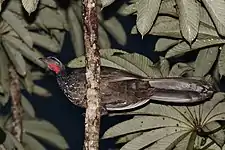Marail guan
The Marail guan or Cayenne guan (Penelope marail) is a species of bird in the family Cracidae, the chachalacas, guans, and curassows. It is found in Brazil, French Guiana, Guyana, Suriname, and Venezuela.[2][3]
| Marail guan | |
|---|---|
 | |
| Marail guan at Presidente Figueiredo, Amazonas state, Brazil | |
| Scientific classification | |
| Domain: | Eukaryota |
| Kingdom: | Animalia |
| Phylum: | Chordata |
| Clade: | Dinosauria |
| Class: | Aves |
| Order: | Galliformes |
| Family: | Cracidae |
| Genus: | Penelope |
| Species: | P. marail |
| Binomial name | |
| Penelope marail (Müller, PLS, 1776) | |
| Subspecies | |
| |
 | |
Taxonomy and systematics
The Marail guan has the two subspecies listed in the box to the right.[2] It and the rusty-margined guan (P. superciliaris) form a superspecies.[4]
Description
The Marail guan is 63 to 68 cm (2.1 to 2.2 ft) long. Males weigh 772 to 1,310 g (1.7 to 2.9 lb) and females 770 to 1,450 g (1.7 to 3.2 lb). The back, wings, and central tail feathers of the nominate subspecies are dark with a greenish olive gloss. The outer tail feathers are bluish black. Its throat and chest are dark with white speckles and the belly reddish brown. It has a red dewlap. P. m. jacupeba is slightly smaller, paler, and more a grayish brown.[3]
Distribution and habitat
The nominate subspecies of Marail guan is found from eastern Venezuela through the Guianas. P. m. jacupeba is found in northern Brazil north of the Amazon River and possibly in southeastern Venezuela, although not all authorities accept the latter.[2][3] It mostly inhabits mature tropical forest though it can be found in secondary forest. In the Guianas and Brazil is favors terre firma forest with dense undergrowth. It is a bird of the lowlands, in Venezuela ranging between 100 and 600 m (330 and 1,970 ft) of elevation.[3]
Behavior
Movement
The Marail guan appears to be sedentary. A study in Suriname found territories ranged in size from 2 to 9 ha (4.9 to 22 acres).[3]
Feeding
The Marail guan forages singly or in groups of up to six, mostly in the canopy and lower levels of the forest but sometimes on the ground. Its diet is almost entirely fruits though insects are occasionally taken.[3]
Breeding
The Marail guan's breeding season varies within its range. It appears to span from October to February in the Guianas and extend further in Brazil. It builds a cup nest high in a tree fork and lays two or three eggs.[3]
Vocal and non-vocal sounds
The Marail guan gives a wing-whirring display, usually before dawn, and usually follows it with a barking "whaf, whaf, whaf". It also gives the barking calls at dusk.[3]
Status
The IUCN has assessed the Marail guan as being of Least Concern.[1] It is fairly common to common throughout its large range but like all guans is subject to hunting pressure.[3]
References
- BirdLife International (2016). "Marial Guan Penelope marail". IUCN Red List of Threatened Species. 2016. Retrieved 27 September 2021.
- Gill, F.; Donsker, D.; Rasmussen, P. (July 2021). "IOC World Bird List (v 11.2)". Retrieved July 14, 2021.
- del Hoyo, J. and G. M. Kirwan (2020). Marail Guan (Penelope marail), version 1.0. In Birds of the World (J. del Hoyo, A. Elliott, J. Sargatal, D. A. Christie, and E. de Juana, Editors). Cornell Lab of Ornithology, Ithaca, NY, USA. https://doi.org/10.2173/bow.margua1.01 retrieved September 27, 2021
- Remsen, J. V., Jr., J. I. Areta, E. Bonaccorso, S. Claramunt, A. Jaramillo, D. F. Lane, J. F. Pacheco, M. B. Robbins, F. G. Stiles, and K. J. Zimmer. Version 24 August 2021. A classification of the bird species of South America. American Ornithological Society. https://www.museum.lsu.edu/~Remsen/SACCBaseline.htm retrieved August 24, 2021
